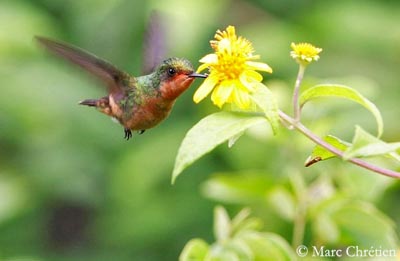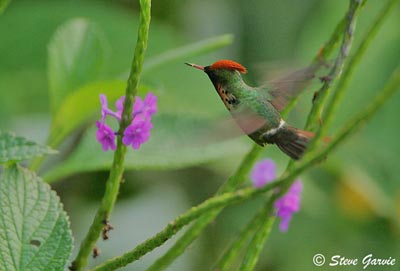
Tufted Coquette – Lophornis ornatus
Apodiforme Order – Trochilidae Family
BIOMETRICS:
Length: 6,5-7 cm ; Weight: 2,3-2,8 g
DESCRIPTION:
Tufted Coquette is a very small hummingbird, more similar to an insect than to a bird.
Adult male has iridescent coppery-green back. The rump shows a buffy-white band, very conspicuous in flight. The uppertail coverts are purplish. The central tail feathers are bronze-green, whereas the other rectrices are rather rufous with green edges and tips. Wings show bronze-green scapulars and darker greyish-green flight feathers. We can see white feathers on thighs.

The underparts are paler green, with more glossy green throat. This bird shows elongated feathers forming a kind of fan from the cheeks. These feathers are bright rufous and each one presents a dark green shiny spot at the tip.
The head shows green forehead, ear-coverts and nape, and a conspicuous long rufous crest on the crown. The straight bill is red, with black tip. Eyes are dark brown. Legs and feet are greyish.
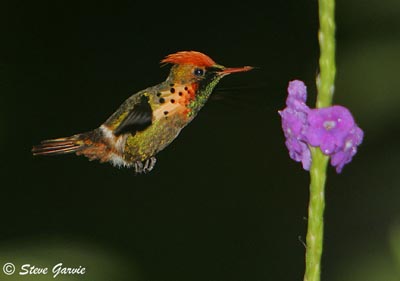
If threatened, the Tufted Coquette approaches the predator by rapid diving attacks, while it gives high-pitched warning calls. Usually, the female uses this behaviour at nest-site against potential intruders. But when it is attacked by larger hummingbird at food source, it weaves away from the predator or leaves the area.
Tufted Coquette is sedentary in its range, because flowering trees which provide nectar are available all year round within the tropical regions where it inhabits.
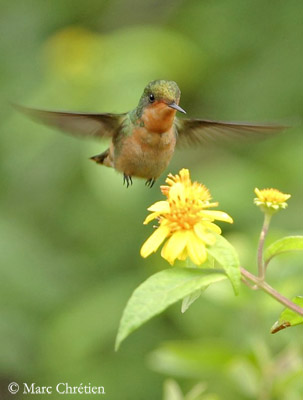
FLIGHT:
Tufted Coquette, as other hummingbirds, is able to fly in all directions when feeding on nectar. It may fly forwards, backwards, sideways, upwards and downwards, in order to enter or to leave a flower. The rapid wing beats produce a kind of metallic buzz. When feeding at flowers, its flight is rather slow and deliberate.
REPRODUCTION:
Breeding season occurs from January to April in Trinidad and from December to March in Guyana.
Tufted Coquette’s nest is usually selected by the female near nectar source.
It is a small cup made with fine materials such as fibres and plant down, situated in vegetation, at about two metres above the ground, on a branch.
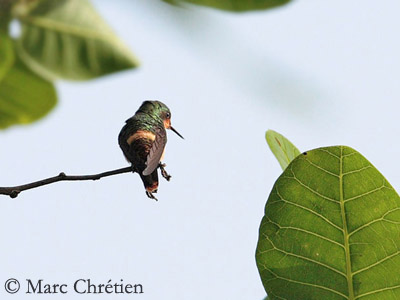
Female usually lays two white eggs. She incubates during two weeks. Young fledge about 20 days after hatching.
They are fed by female by regurgitated mixed food including nectar and tiny invertebrates. After leaving the nest, the young are still fed by the female during 18 to 25 days.
Young remain at the same place during several days, usually high in trees, and female comes to feed them. Later, when they are able to fly well, the young follow their mother to the feeding areas, in order to learn how to feed themselves.
DIET:
Tufted Coquette feeds mainly on nectar from flowers of several plant species. It also consumes small invertebrates.
PROTECTION / THREATS / STATUS:
Tufted Coquette is common in its range, and this species is not threatened at this moment.
Fr: Coquette huppe-col
All : Schmuckelfe
Esp : Coqueta Adornada
Ital : Colibrì coquette ornato
Nd : Gekuifde Koketkolibrie
Photographs by Steve Garvie
RAINBIRDER Photo galleries
Photographs by Marc Chrétien
His website : MURINUS
Text by Nicole Bouglouan
Sources:
HANDBOOK OF THE BIRDS OF THE WORLD Vol 5 by Josep del Hoyo-Andrew Elliott-Jordi Sargatal - Lynx Edicions - ISBN: 8487334253
Discovering the birds of Trinidad and Tobago (Brian Ramsey)
Wikipedia (Wikipedia, The Free Encyclopedia)
Female is slightly different. She lacks the crest and the fan-like tufts on head sides. She has buff band on the rump. The uppertail feathers show entire bronze-green central rectrices, and second half of external feathers, which are rufous at the base. Tail is tipped pale rufous to cinnamon. She has blackish bill. The underparts are rufous, paler on belly, and green on flanks.
The immature is similar to female, with whitish throat showing fine dark spots.
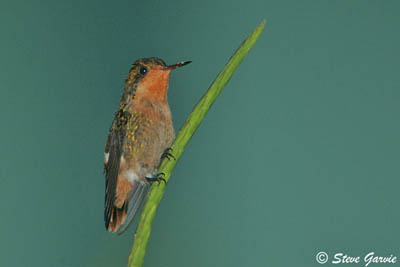
VOICE: SOUNDS BY XENO-CANTO
Tufted Coquette utters light “chik” while feeding.
HABITAT:
Tufted Coquette lives at the edges of humid forest, in thickets, gardens and plantations. It is visible from 100 to 1000 metres of elevation.
RANGE:
Tufted Coquette lives in the north-eastern of South America, in eastern Venezuela, Trinidad, the Guianas and northern Brazil.

